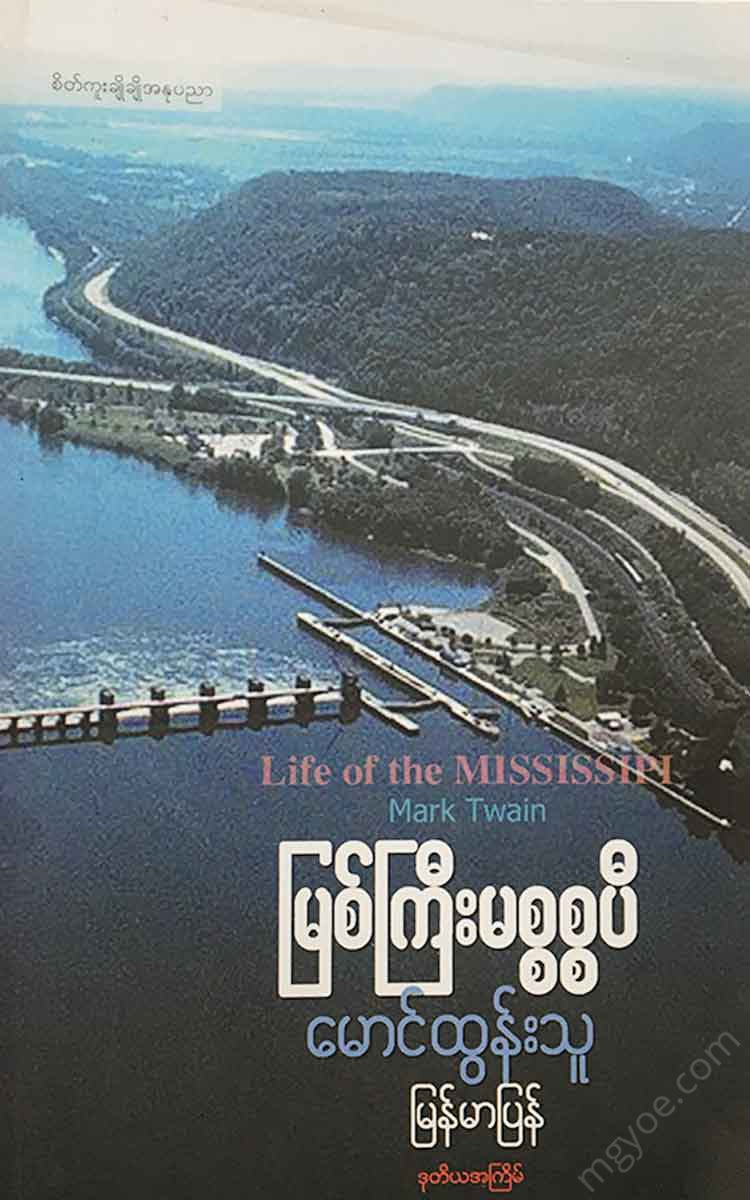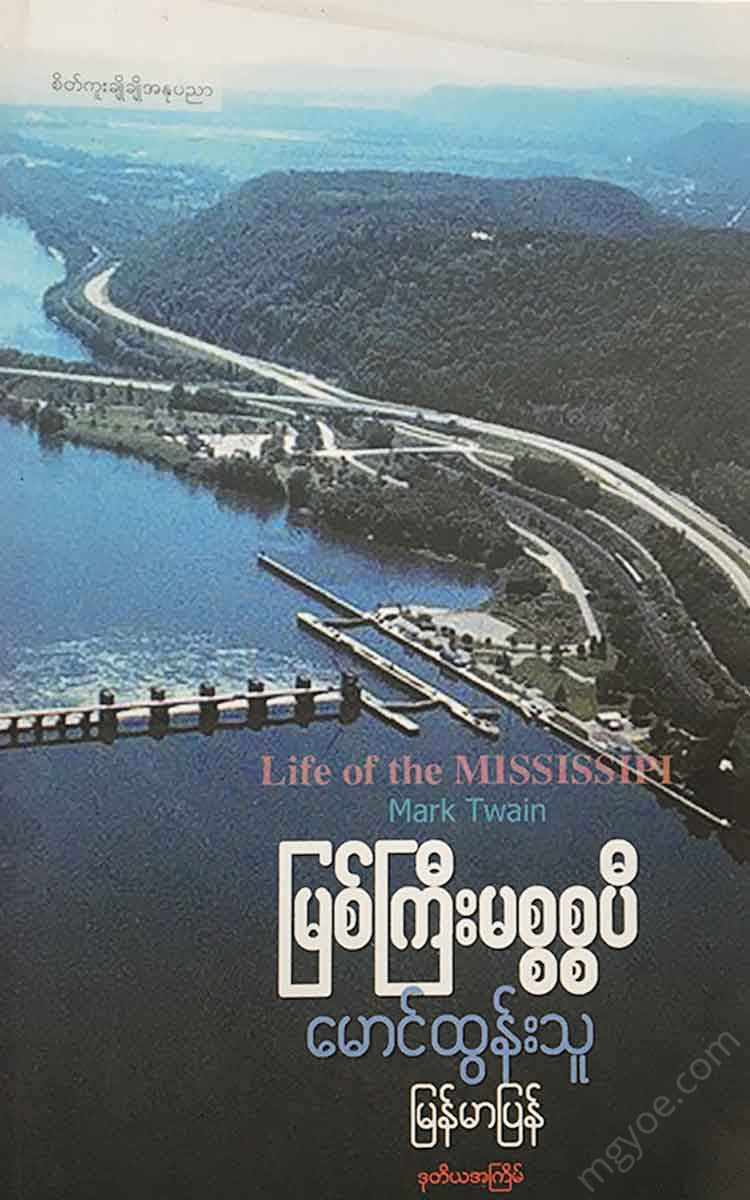စိတ်ကူးချိုချိုစာပေ
Maung Tun Thu - Myitkyina Mississippi
Maung Tun Thu - Myitkyina Mississippi
Couldn't load pickup availability
The Mississippi is a good subject to read about. This is no ordinary river. It is a river with unique features on all sides. The Mississippi, including its main tributary, the Missouri River, is the longest river in the world, at four thousand three hundred miles long. It is also the most winding river in the world. Of the thirteen hundred miles of this river that people use, only six hundred and seventy-five miles are long enough for a crow to fly straight.
The water power of this river is three times greater than that of the St. Lawrence. Twenty-five times greater than that of the Rhine. Three hundred and thirty-eight times greater than that of the Thames. No other river has a basin so vast. It is fed by twenty-eight states and territories. It is fed by the state of Delaware on the Atlantic coast, and by all the wilderness between that state and the state of Idaho on the lower slopes of the Pacific coast, extending to fifteen degrees of longitude.
The water received by the Mississippi River and carried to the Gulf is from fifty-four tributaries navigable by steamboats and from some rivers hundreds of miles long, where rafts and large barges can enter and exit. The area of the Mississippi River basin is equal to the area of all the basins of England, Wales, Scotland, Ireland, France, Spain, Portugal, Germany, Austria, Italy, and Turkey combined. Almost all of this vast area is very fertile. The Mississippi Valley is an exceptionally fertile region.
Another peculiarity of the Mississippi River is that instead of widening as it approaches its mouth, it gradually narrows and deepens. From its confluence with the Ohio River to about halfway to the sea, the river is about a mile wide. From there, however, the river gradually narrows. When it reaches the "valley roads" above the mouth, the river is only a little over half a mile wide. At its confluence with the Ohio River, the Mississippi is about eighty-seven feet deep. Gradually, the water becomes deeper, and by the middle of the river, it is one hundred and twenty-nine feet deep.
There was an article in the New Orleans Times-Democrat. Based on reports from knowledgeable engineers, the article stated that the Mississippi River annually dumps four hundred and six million tons of silt.
The Mississippi River is said to be being dumped into the Gulf of Mexico. The mud has solidified and transformed into a mass of land about a square mile in area and two hundred and forty-one feet high. The years of this mud have gradually built up the mass of land, making it larger and larger.
Another peculiarity of the Mississippi River is that it passes over narrow stretches of land. In these places the river flows in a straight line. It is not long, and at one point it is only thirty miles long. Such crossings have produced strange effects. In the wilderness of the country, port towns have sprung up, and in front of them lie vast sand dunes and forests. In addition, the location of the Delta, which was formerly three miles below Vizsla, has been completely changed by the passage of the Mississippi River. The Delta is now two miles above Vizsla.
The sudden flow of the Mississippi River caused both of these river towns to retreat into the wilderness. This flow greatly altered the boundaries and jurisdictional implications. For example, a person living in the Mississippi today finds himself and his land on the other side of the river the next day, as a result of a sudden flow that occurred early that night, and he and his land are now in Louisiana, and are subject to the jurisdiction of that state. In ancient times, such events frequently occurred in the upper reaches of the river, and a slave from Missouri was often found to be freed by the flow of the river into Illinois.
The Mississippi does not change its location by simply moving in and out of the way. It also changes its entire course. In the Hard Time region of Louisiana, the Mississippi occupies a width of about two miles in the western part of that region. However, due to the change in the course of its original course, that region is no longer in Louisiana. The entire region has moved across the river to Mississippi.
We will read more about the peculiarities of the Mississippi River in the future, so for now, this much is enough. Therefore, it will be necessary to forget for a moment the appearance and location of the Mississippi and learn a little about its history.
The first white man to see the Mississippi River was “De Soto.” He saw it in 1542. He did not describe the beauty of the sunset he saw, and he did not describe any other details. Therefore, we only know that it was a sunset, and no one saw it in person. We can only wish that De Soto had painted a picture of the sunset he saw.
In any case, when De Soto first discovered the Mississippi River, the name of Saint Ignatius of Loyola, the founder of Roman Catholicism, was still obscure and unknown. Roman Catholicism had not yet been established for a year. The paint on Michelangelo's "Last Judgment" on the wall of the Sistine Chapel had not yet dried.
At that time, Mary Queen of Scots had not yet been born. Catherine de Medici, who would become the wife of King Henry II of France, was still a child. Queen Elizabeth of England was still a teenager. French Protestant reformer John Calvin, Italian painter Benvenuto Cellini, and Spanish King Charles V, the Holy Roman Emperor, were all at their most famous. Each of them was trying to make his mark on history in his own way.
When De Soto arrived on the banks of the Mississippi River, the German Reformer Martin Luther had not yet died; De Soto died two years after he arrived on the banks of the Mississippi River. He arrived eleven years before the burning of Servite and thirty years before the St. Bartholomew's Day massacre. The book "Rabbi Lace," which would become famous in later times, had not yet been published. The great Spanish writer Cervantes, who was famous in this period, had not yet written his great novel "Don Quixote," which was also very popular. The English poet and playwright Shakespeare had not yet been born. It was almost a century before the English people heard the name of Oliver Cromwell, who stood out as a great leader in English history.
The discovery of the Mississippi River is not difficult to determine. There is no doubt that its discovery led to new developments, changes, and improvements in our country.
De Soto died after only seeing the Mississippi River, and his priests and soldiers buried him in the river. When the Spanish returned to their homeland, as was customary in those days, the priests and soldiers probably exaggerated the size and character of the Mississippi River tenfold.
Thus, adventurers among the people who had become interested in the Mississippi River immediately set out to explore it. When they returned to their homelands and told what they had seen, they found nothing remarkable enough to excite their curiosity. Here the Mississippi River was abandoned for many years, without any white man visiting it. The interval between further contact with the Mississippi was not long in time. This period can be calculated in this way:
Shakespeare was born a few years after De Soto saw the Mississippi River. He lived for more than fifty years, writing poems and plays, and died. It was more than fifty years after he went underground that a second white man saw the Mississippi.
In fact, in our time, if a strange place is discovered, it is not left for a hundred and thirty years without further investigation. Suppose someone finds a stream in a region called the North Pole. Fifteen teams from Europe and America, at great expense, are sent to study it. If one team systematically investigates the stream, the other fourteen teams will join in and study it.
In any case, white men had been settling on our Atlantic coast for over a hundred and fifty years. All of these white men had been in close contact with the Indians. In the south, the Spanish were attacking the Indians. They were robbing them. They were enslaving them. They were converting them to Christianity. Upstream, the English were selling them colorful beads and blankets. They were enticing them into their culture, offering them “whiskey” as a gift with every purchase.
In Canada, the French were providing basic education to the Indians, converting them to Christianity, and attracting large numbers of people to come first to Quebec and later to Montreal to buy furs.
These white men must have heard of a great river far to the west of their native lands. In any case, their hearing was vague. It was not certain. It was difficult to estimate the size and extent of the river, or its location. The mystery of this news not only aroused the curiosity of the people, but also intensified their desire to go and investigate the unknown region. However, this did not happen.
It is clear that no one wanted such a river. They did not think it was necessary. They did not see it as something special. Thus the Mississippi River continued to exist undisturbed, outside the market, for another hundred and fifty years. When De Soto found the Mississippi River, he was not looking for a river. Therefore, he did not value the Mississippi. He did not show any particular interest.
But finally, a Frenchman named "Lascelles" thought it would be useful to search for and explore the river without finding it. It is a common phenomenon in the human world that when a person realizes that he has grasped an important idea that many have rejected, many others eagerly follow it. This is also the case in this case.
Here, as is natural, a question arises. Why are people now interested in a river that no one had been interested in for five generations? The obvious answer to this question is that in later times people thought they had found a way to use this river. Furthermore, it was believed that the Mississippi River emptied its waters into the Gulf of California. This would have provided a shortcut from Canada to China. In the past, people thought that the Mississippi River emptied its waters into the Atlantic Ocean or the Virginia Sea, didn't it?
It is clear that no one wanted such a river. They did not think it was necessary. They did not see it as something special. Thus the Mississippi River continued to exist undisturbed, outside the market, for another hundred and fifty years. When De Soto found the Mississippi River, he was not looking for a river. Therefore, he did not value the Mississippi. He did not show any particular interest.
But finally, a Frenchman named "Lascelles" thought it would be useful to search for and explore the river without finding it. It is a common phenomenon in the human world that when a person realizes that he has grasped an important idea that many have rejected, many others eagerly follow it. This is also the case in this case.
Here, as is natural, a question arises. Why are people now interested in a river that no one had been interested in for five generations? The obvious answer to this question is that in later times people thought they had found a way to use this river. Furthermore, it was believed that the Mississippi River emptied its waters into the Gulf of California. This would have provided a shortcut from Canada to China. In the past, people thought that the Mississippi River emptied its waters into the Atlantic Ocean or the Virginia Sea, didn't it?





